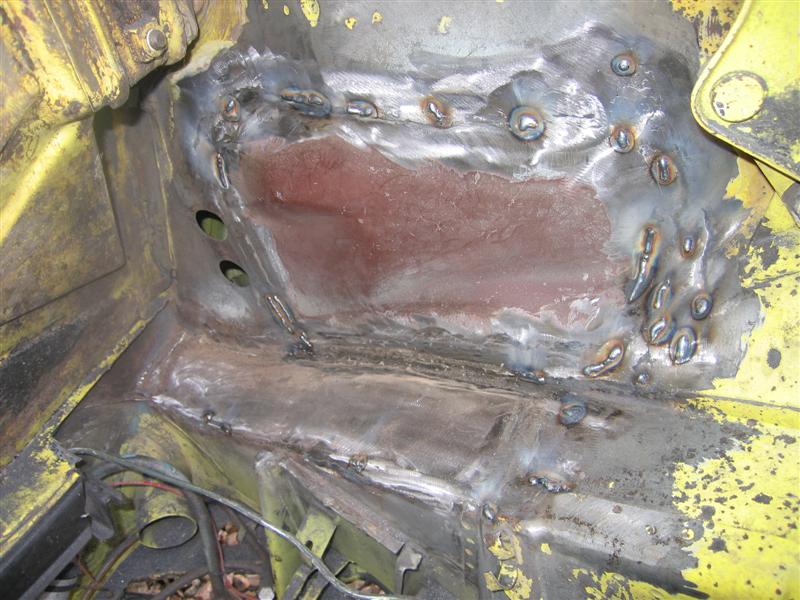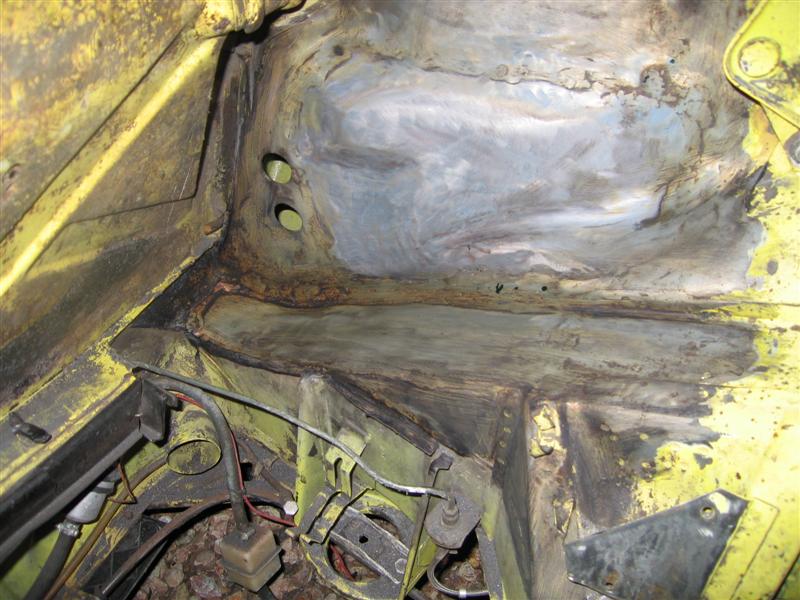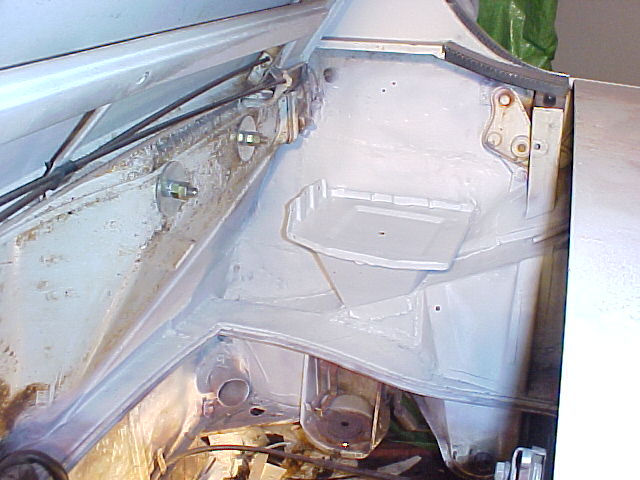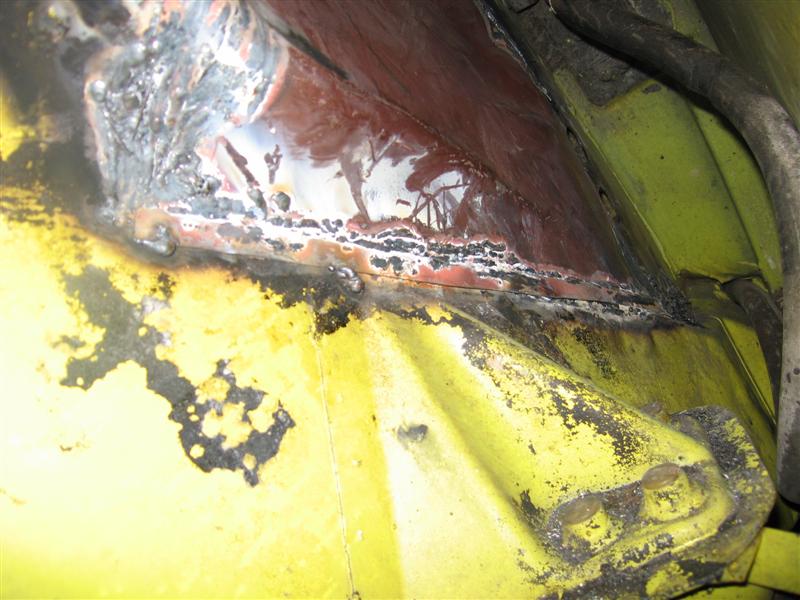Printable Version of Topic
Click here to view this topic in its original format
914World.com _ 914World Garage _ butt head, butt weld..
Posted by: Travis Neff Feb 14 2005, 02:09 PM
Hey all,
I have been trying to patch up A/C holes in my tub and having a helluva time blowing holes in the metal and voids around the weld area. I start with tacks in the corners and start tacking around the world in an offset pattern, when I have about 12 tacks in a circle I try to join the tacs. However when I tac, I most always blow a hole in the new sheet metal, or in the old panel. I have the worst time in the vertical position. I have ground down both sides of the panel (and patch) to clean metal. If I am not blowing a hole, only about 50% of the weld gets good penetration, when I hit it a little longer I blow a hole. I have even used a sorta chill bar to back the joint (1" copper pipe squished flat with a bend, suggested by another lister). Also, I am making most of my holes just buzzing a tack, not so much once I have an arc established.
I have a Millermatic 175, using .023 wire and Argon/CO2 (about 24lbs pressure when I hit the switch), Guide states I should use #2 on voltage and 50 on the wire feed speed. I have no problems welding lap joints at these settings and it sounds like bacon frying when it does it, so I know I am close.
I have gone down to 1.5 on voltage and reduced the wire feed to 40, still no luck. I have expanded my stickout (experimenting with 1" plus down to the 3/8's I normally do). The welds suck. Once I get done and grind the welds down smooth I almost always find a crack/void where the metal joins the weld. Weld, grind, weld grind. I can eventually get it right, fixing each one of the patches once I grind it down. I have tried the butt weld clamps, but the gap is huge, I can get the metal to almost (or actually touch) and hold it in with a magnet.
What am I missing? Should I be using metal ready to clean the metal even further, try another technique? I am holding the gun at an upward angle and a touch over to the side (hell I have tried just about everything).
Posted by: Mueller Feb 14 2005, 02:19 PM
it's just practice...are you making little circles when you weld??
with enough practice you should be able to fill up a 1/2" hole with nothing behind it (I don't like the "chill" bar method)
is it windy near your welding location? your shielding gas could be getting blown away???
Posted by: Travis Neff Feb 14 2005, 02:29 PM
Ahh practice, I have been doing a lot of that. When I refilled my tank at my local welding store after 4 weeks (80cf), he said I must have been very busy! However not a lot of butt welding in a veritcal layup - that is next.
No wind, in the garage and my mouth breathing while welding is not affecting anything either with my nifty autodarkening helmet.
I tried the chill bar and only helped me a little bit, I mostly do without. Seems as soon as I blow a hole, then try to fill that hole (letting the metal cool or not) just blows the hole bigger, that is why I am questioning contamination on the metal surface.
Posted by: Travis Neff Feb 14 2005, 02:30 PM
Oh, no little circles - I will try that. I am almost closing the gaps with tacks (like they are almost touching, then hit the spurs to it once around the hole (in segments).
Posted by: TimT Feb 14 2005, 04:28 PM
Sounds like to much juice, even though the book say use settin #2. try a lower heat setting.
oh and practice!!
![]()
Posted by: MarkV Feb 14 2005, 05:09 PM
I have been going through the same thing. Using a Lincon w/ .023 wire CO2/argon my machine calls for C voltage and 2.5 wire speed. I discovered that if I increase the wire speed to 3.5 that the penetration isn't as good but it works great for filling pin holes.
I shoudnt have tried to butt weld this:
Attached image(s)
Posted by: Eric_Shea Feb 14 2005, 05:20 PM
After reading the first post I would have said slower speed and less voltage. I think you may just want to slow the wire down a bit.
Posted by: SirAndy Feb 14 2005, 05:24 PM
| QUOTE (Eric_Shea @ Feb 14 2005, 03:20 PM) |
| After reading the first post I would have said slower speed and less voltage. I think you may just want to slow the wire down a bit. |
Posted by: Root_Werks Feb 14 2005, 05:32 PM
Yep, a lot of times you can have the voltage about right and the wire speed will feed faster than it can melt, punching holes. Low voltage, slow wire speed, little circles. You can almost see a little "horse shoe" when you weld. ![]()
Posted by: Mueller Feb 14 2005, 05:34 PM
| QUOTE (SirAndy @ Feb 14 2005, 04:24 PM) | ||
|
as Jack Burton say's "it's all in the wrist"
Posted by: chunger Feb 14 2005, 06:00 PM
I thought jack burton said, "It's all in the reflexes".
![]()
Posted by: riverman Feb 14 2005, 06:06 PM
Try and have a small gap between the two pieces of metal your trying to join (1 or 2mm) and turn down your voltage and turn up your wire speed. It won't burn as hot (less blowouts) and it will deposit more filler metal into the gap. You'll have to play with your settings to see what works best on your machine.
Posted by: MarkV Feb 14 2005, 06:13 PM
![]() If I slow the wire down the welds look better but I make a new hole at the edge of the hole I just filled. More wire speed is the ticket for me.
If I slow the wire down the welds look better but I make a new hole at the edge of the hole I just filled. More wire speed is the ticket for me.
![]()
Posted by: John Kelly Feb 14 2005, 06:46 PM
Also try welding more briefly. A quick zap, then another. If a hole opens up, aim the wire at the edge of the hole, zap, wait, zap again...
John www.ghiaspecialties.com
Posted by: trekkor Feb 14 2005, 07:30 PM
I don't understand why everyone wants to do butt welds. Especially in "invisible" areas of repair.
Lap welds are faster and may even be stronger.
I noticed the other day, all the lap welds in the construction of the body of my car. They're everywhere.
Might be tough to even find a butt weld ![]()
KT
Posted by: 9146986 Feb 14 2005, 09:38 PM
What everyone says about technique is right. Practice with the same kind of metal you are welding on the car, and go ahead and blow holes and weld them up. It's the only way you are going to get the hang of it.
Another thing you can try (off the car first of course) is to run about 3" of wire out before you make your arc. It takes a little bit of practice to get the hang of it, but it helps keep it from blowing holes.
I use a copper spoon to weld up holes, when it's possible, but you've got to work on that technique too, so you get good penetration and everything is stuck together well.
Makes me think of the first time (20 yrs ago) I tried to weld sheet metal, and NOT with a wire MIG. Had one of the venerable old Lincoln 225's, great for stick welding 1/4" thick or more, but take a small electrode, turn the amperage down, and POW it'll blow a hole through 20 gauge sheet metal the size of a half dollar in the blink of an eye. Oh jeez....wtf....oops did I do that ![]()
A lap weld can be an acceptable repair, as long as the lapped side of the joint isn't exposed to moisture. This is hard to pull off on a floorpan unless the car is on it's side, or upside down. I would NEVER lap weld flairs, I don't car what any body man says. Talk to any quality restoration shop and see what they say.
Posted by: xsboost90 Feb 14 2005, 09:49 PM
yeah, lay off he juice...or speed and volts that is. When its right youll be able to tell, you can fill in holes like a ice cream sundae maker.
Posted by: Mueller Feb 14 2005, 09:52 PM
| QUOTE (trekkor @ Feb 14 2005, 06:30 PM) |
| I don't understand why everyone wants to do butt welds. Especially in "invisible" areas of repair. Lap welds are faster and may even be stronger. I noticed the other day, all the lap welds in the construction of the body of my car. They're everywhere. Might be tough to even find a butt weld KT |
that "invisible" part can come back and bite you in the @ss, you cannot see behind the lap joint and if the material was not coated correctly before and after welding, any moisture that gets back there will cause rust down the road.....a butt weld has no "hiding" places.....yes, a lap weld can be a lot stronger due to you having more surface area for welding....you will find some rust behind some of the lap joints the factory did.....
..as with any kind of repair or job, there is normally more than one way to do it...
Posted by: trekkor Feb 14 2005, 10:04 PM
So I'll have to replace the battery tray and area again in 30 years. ![]() O.K.,Maybe 20
O.K.,Maybe 20 ![]()
I don't know how to rust proof steel forever.
First one who does gets to be the richest person on the planet.
KT
Posted by: MarkV Feb 14 2005, 10:11 PM
I just did it for cosmetics. Now that I spent 3 hours grinding it should be kind of invisable. Did a lap on the top of the long w/ 16 gauge & blended it in.
Attached image(s)
Posted by: trekkor Feb 14 2005, 10:24 PM
Looks great. Nice job.
When I said "invisible", I meant areas you cannot see or have to work to see.
In my engine compartment you have to lean over and stick your head down in there to see the seams in my patches.
Bothers some people. Not me... ![]()
Attached image(s)
Posted by: MarkV Feb 14 2005, 10:32 PM
Yea, I screwed up and made a bunch of extra work for myself. Once I started there was no turning back.
Now I have to try to clean up all of the weld wire hanging inside the fender. My die grinder will just barely fit in there.
Attached image(s)
Posted by: Mueller Feb 14 2005, 10:38 PM
| QUOTE |
| When I said "invisible", I meant areas you cannot see or have to work to see |
to some people it's a "hack" method..whether it'll be seen or not...and yes, I've done a few of those jobs myself
Posted by: Travis Neff Feb 14 2005, 10:39 PM
If I go down to 1 or even 1.5 I can see the arc strike and the wire burns up to the nozzle, wire feeds and burns up, so slow I can see and hear it buzz, fizzle, buzz fizzle. I will try the circular motion, same amperage range 1.5-2 and just turn down my wire speed. Again, I am getting blowouts once the arc strikes, when an arc is established and there is no blow out - no problemo' When filling those holes, I shoot at an angle at the corner of the hole, generally blowing yet another hole. Once I get it filled I got a big ole booger of weld to grind down and the penetration is flakey, where you can see voids/seams where each of the welds layer each other.
Thanks all, these are some great ideas. I'll let you know how I progress.
Posted by: Travis Neff Feb 14 2005, 10:44 PM
Sorry I should have said low voltage and really low wire feed speed where I can see that buzz, fizzle. I should try lower wire speed like maybe 30 and try at 2 on the voltage. I will also try the super long stickout as well.
Posted by: TimT Feb 15 2005, 06:40 AM
If you can see the wire burn up to the nozzle, you either need more wire speed, or less amperage, or a combination thereof. Also reversing polarity may help, but lets not go there just yet ![]()
Posted by: Brando Feb 15 2005, 10:38 AM
| QUOTE (9146986 @ Feb 14 2005, 07:38 PM) |
| ... A lap weld can be an acceptable repair, as long as the lapped side of the joint isn't exposed to moisture. This is hard to pull off on a floorpan unless the car is on it's side, or upside down. I would NEVER lap weld flairs, I don't car what any body man says. Talk to any quality restoration shop and see what they say. |
Why not lap-welf flares on? Just use a flange-tool and flange the metal on the body and lap weld it on both sides (inside and outside). Then grind smooth. Why's that the wrong method?
Posted by: trekkor Feb 15 2005, 10:53 AM
![]()
I approve that last post!
I've always thought that would be the fastest/strongest method. Seen it more times than not, too.
KT
Posted by: Travis Neff Feb 16 2005, 10:39 AM
Ok, so I went down to 1, then .5 on voltage and kept the wire speed up to about 40, ran some butt weld coupons in the vertical position, and doing cirlces.
That all helped well, if I blew a hold Perry's idea of a 3" stickout, hit the hole and move in quick (to normal stickout length) works great.
Penetration got better but not good enough, either slowing way down helped but deposition on the top side increased. Just trying to get the hang of it I was back at the #2 on voltage and 50 on wire feed. Just when I was getting some good runs I ran outta gas.. Damn, I just had that filled 2 weeks ago - last tank did 6X the welding and lasted 3 times longer. Must have gotten a partial filled tank or somethin'
Posted by: John Kelly Feb 16 2005, 04:54 PM
| QUOTE (Brando @ Feb 15 2005, 08:38 AM) | ||
Why not lap-welf flares on? Just use a flange-tool and flange the metal on the body and lap weld it on both sides (inside and outside). Then grind smooth. Why's that the wrong method? |
It is not a wrong method, just an inferior method. You can minimize or eliminate the use of filler on a butt-welded panel by using a hammer and dolly, whereas the lapped joint is unworkable and will require more filler. I use lap joints in lots of places, but I try not to on the outside body shell....just a better practice.
John, www.ghiaspecialties.com
Posted by: 9146986 Feb 16 2005, 05:37 PM
| QUOTE (Brando @ Feb 15 2005, 08:38 AM) | ||
Why not lap-welf flares on? Just use a flange-tool and flange the metal on the body and lap weld it on both sides (inside and outside). Then grind smooth. Why's that the wrong method? |
A set of steel flairs is going to run around $1000 right? Why scrimp on installation by welding on with a lap joint? Yes it takes more time and talent.
The wheel house area is a high moisture area. You will never get that joint sealed perfectly, water will eventually invade the joint, and it will come back to haunt you. Capillary action will eventually make sure that water will violate the seam.
What's the first thing people who know something about quality restorations do to a flaired car? They reach under the fender and feel the seam. Why? To see if it was done right.
Posted by: trekkor Feb 16 2005, 05:48 PM
Must... resist...debate. ![]()
I just want to see one butt joint on the original tub.
I'm out ![]()
KT
Posted by: Travis Neff Feb 16 2005, 06:03 PM
You obviously have missed Zois' avatar, but hey I guess he blacked out that cracker, or he is suffering from some capillary action...
Posted by: John Kelly Feb 17 2005, 08:48 AM
| QUOTE (trekkor @ Feb 16 2005, 03:48 PM) |
| Must... resist...debate. I just want to see one butt joint on the original tub. I'm out KT |
I'm guessing if the factory did add-ons (flares?), they butt-welded them. If they didn't they were cutting corners. Don't get me wrong, I believe in being realistic about how much time you can put in (it's just a car)....but there is no superior method to butt-welding in the middle of a panel.
John www.ghiaspecialties.com
Posted by: scotty b Feb 17 2005, 08:59 AM
| QUOTE (trekkor @ Feb 16 2005, 03:48 PM) |
| Must... resist...debate. I just want to see one butt joint on the original tub. I'm out KT |
There aren't any butt joints on the car because the panels were stamped as one piece from the factory!! The lapped joints that are there were both faster and provide strength. 1 layer vs. 2, that said butt welding patch panels is my preferd way because of A: cosmetics, B: the rust between layers issue, C: faster is not better,D: thats the way it came !. If you prefer to lap or can't butt weld then go for it. In life you will find that the things that take longer to complete will be better in the end. Ask J-HO errrr J-Lo
Posted by: Mueller Feb 17 2005, 09:09 AM
| QUOTE (trekkor @ Feb 16 2005, 04:48 PM) |
| Must... resist...debate. I just want to see one butt joint on the original tub. I'm out KT |
what you are totally missing here is that the butt welding is for "repairs" or for the added on flares so the the panel appears to be one-piece or seamless....a GT flare does not need the strength the laps would give you...the 914 was spot welded together to save money, how else are you going to spot weld without having overjoining laps.....
Shelby Cobra bodies have the panels butt welded together, I guess they didn't know what they were doing
It's job specific on how a method is approched.....
using the excuse the factory did or didn't do it is pretty weak
Posted by: trekkor Feb 17 2005, 10:22 AM
| QUOTE |
| I'm out |
I'm back in...
Before I go any further, know this: I am not judging or critisizing anyone. Nor am I upset or flaming ( definately not flaming )
People need to know it's o.k. to do things their way, too.
| QUOTE |
| The wheel house area is a high moisture area. You will never get that joint sealed perfectly, water will eventually invade the joint, and it will come back to haunt you. Capillary action will eventually make sure that water will violate the seam. What's the first thing people who know something about quality restorations do to a flaired car? They reach under the fender and feel the seam. Why? To see if it was done right. |
As far as concerns about moisture damage go, what about the fiberglass installs? ( all lapped ) I'm not hearing too much ( read any ) complaints about fenders falling off.
Back to steel...The three really nice flare jobs here in the Bay Area I've seen are all lapped. They look great and you cannot tell unless you feel under there or look.
I try not to do that...
| QUOTE |
| I'm guessing if the factory did add-ons (flares?), they butt-welded them. If they didn't they were cutting corners. Don't get me wrong, I believe in being realistic about how much time you can put in (it's just a car)....but there is no superior method to butt-welding in the middle of a panel. |
Guessing? Hmm
John I saw your video, don't get me wrong. You are a master. The work you do is amazing and inspiring.
Are you working the inside of the panels to hide evidence of body work, too? That would be insane. ( in a good way )
| QUOTE |
If you prefer to lap or can't butt weld then go for it. In life you will find that the things that take longer to complete will be better in the end. |
There are many ways to approach every project.
Budget and time usually influence us
I wasn't willing to spend another 10-20 hours in the battery area just so I could say "look, butt welds".
A non cosmetic area should be a non-issue.
Taking longer doesn't always mean better. Just longer.
| QUOTE |
| It's job specific on how a method is approched..... using the excuse the factory did or didn't do it is pretty weak |
Job specific, yes. People using factory tested methods as a base for their restorations and replicas, weak?, not a chance.
Be careful when you perk up the ears of the majority of the car buffs out there.
I will use whatever methods I deem neccesary to complete my projects. I not a know it all. More of a don't know much at all
Thanks to all for the help and advice. And for threads like this.
KT
Posted by: John Kelly Feb 17 2005, 02:42 PM
KT,
Thanks for the kudos, but I'm no master...I overlap lots of places, and I don't care what a panel looks like on the inside...I just like to save my best work for the body skin...butt welds are not that much more work and provide a nice smooth surface for filler if you are not going to metal-finish your welds. Lap joints leave an edge into which filler can shrink over time showing the seam. Or, if you flange the lap joint, you run the risk of distorting the panel that is flanged where the seam curves....and use more filler. Just a question of making an informed choice....we all make our own rules in the end. Some of what I do would horrify a concourse judge...do I care? No.
John www.ghiaspecialties.com
Powered by Invision Power Board (http://www.invisionboard.com)
© Invision Power Services (http://www.invisionpower.com)